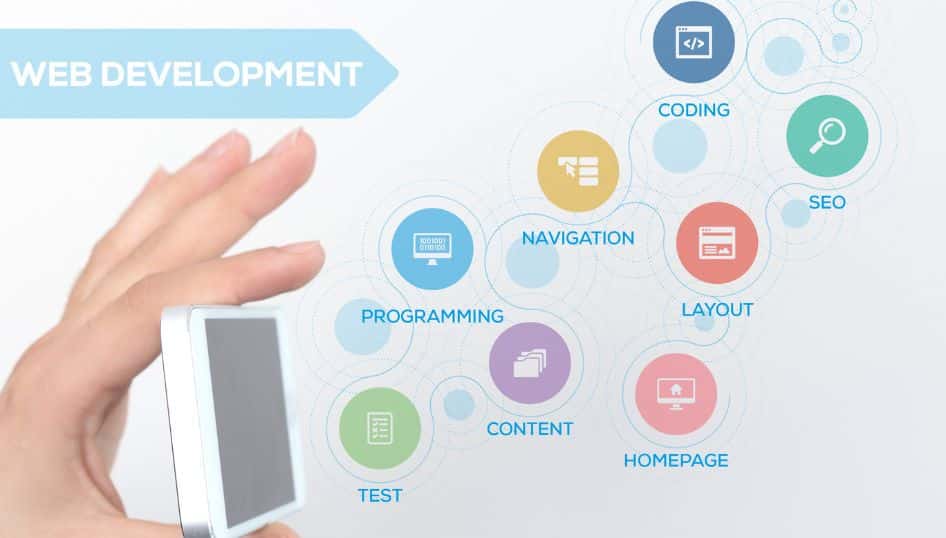The definition of web development
Web development is creating and maintaining websites and web applications on browsers. This involves technical tasks such as coding, programming, and configuring network security, as well as creative elements like user experience and design.
The field of web development is divided into two parts – front-end development and back-end development. Front-end developers handle the user-facing or client side of a website. In contrast, back-end developers deal with the server side. To accomplish their tasks, web developers use different coding languages, including HTML, CSS, and JavaScript, depending on the platform and job at hand.
Web development includes the basic framework for building websites and web applications and web design, web programming, and database management. Content management systems like WordPress and Joomla are commonly used to aid in constructing sites that would otherwise need to be built “from scratch” by writing code.
Web developers are responsible for ensuring that websites are visually appealing, load quickly, and offer a seamless user experience. They do this by creating responsive websites and writing code in various programming languages, which vary depending on the task and platform they are working on.

The History of Web Development
In 1989, Sir Tim Berners-Lee invented the World Wide Web to solve the challenge of sharing information faced by people at CERN. He proposed a project and began working on it in September 1990, using a NeXT computer. By October of that year, he had written HTML, URI, and HTTP, the foundation of today’s web. Lee also wrote the first web page editor/browser and web server, and the first web page was served on the open internet in 1990. In 1991, people outside CERN were invited to join the new web community, and in April 1993, CERN agreed to make the underlying code available royalty-free
The importance of web development
- A strong web presence helps businesses reach millions of potential clients, even if the service is localised.
- A well-designed website showcases products/services, explains their relevance, and highlights unique qualities that set a business apart from competitors.
- Effective communication with customers via a website is crucial for generating more business.
- A responsive website design improves connectivity and attracts more visitors.
- A website showcases a business’s credibility, expertise, and experience, which builds trust with potential customers.
- There are many job opportunities available for web developers.
What is the difference between website design and website development?
There are many differences between web design and website development. Web design is the visual look of a site, images, text, graphics etc. The site’s usability (UX design) is also often considered during the web design process. Website or web development includes all aspects of making a site functional to search engines and viewers, including web publishing, programming and database management. Web development services are needed for designs to be functional.
Types of Web Development
Web development falls into three categories: front-end development, back-end development, and full-stack development.
What Is Front-End Development?
Front-end developer front-end web development is the process of building and maintaining the user interface (UI) and user experience (UX) of a website or web application. It is part of web development that deals with the look and feel of a website. Front-end developers use HTML, CSS, and JavaScript to create the visual elements of a website, as well as interactive features.
Front-end web development is an essential part of web development, as it is the first thing users see when visiting a website. A well-designed front end can make the visual aspects of a website more user-friendly and visually appealing.
Front-end web developers use a variety of tools and techniques to create websites. Some of the most popular tools and techniques include:
- HTML: Hypertext Markup Language is the standard markup language for creating web pages.
- CSS: Cascading Style Sheets is a language used to describe the presentation of web pages.
- JavaScript: JavaScript is a programming language that adds interactivity to web pages.
- Frameworks: Frameworks are pre-built libraries that can be used to build websites. Some popular frameworks include React, Angular, and Vue.js.
What Is Back-end Development?
Back-end web development is the process of building and maintaining the functionality of a website or web application. Part of web development deals with the servers, databases, and other systems that power a website. Back-end developers use a variety of programming languages and tools to build and maintain back-end systems.
Some of the key responsibilities of a back-end developer include the following:
- Designing and implementing the architecture of a website or web application
- Developing and maintaining the back-end code
- Configuring and managing the servers and databases
- Testing and debugging the back-end code
- Monitoring the performance of the back-end systems
What Is a Full-Stack Developer?
A full-stack developer is a web developer who can handle a website’s front-end and back-end. They are familiar with various programming languages and technologies and can work on all aspects of a website development project.
Full-stack developers are in high demand, as they can save companies time and money by being able to do all aspects of web development themselves. They can also be more creative and innovative, as the constraints of a specific programming language or technology do not limit them.

The web development process
- PlanDefine your goals and target audience.
- Make a sitemap. Visualise the layout of your site.
- Buy a domain name. Your domain name is your site’s URL.
- Develop your back end. Code the back end of your site.
- Build your front end. Code the front end of your site.
- Publish your site. Make your site live and available to the public.
Here is a detailed explanation of each step:
- Plan
Define your goals and target audience. What do you want your website to achieve? Do you want to sell products, generate leads, or provide information? Once you know your goals, you can design your website accordingly.
You should also identify your target audience. Who are you trying to reach with your website? Once you know your target audience, you can tailor your content and design to appeal to them.
- Make a sitemap
- Visualise the layout of your site. A sitemap is a document that lists all the pages on your website. It helps you organise your content and ensure your website is easy to navigate.
You can create a sitemap manually or use a tool like Google Search Console. - Buy a domain name
- Your domain name is your site’s URL. It is the address that people will type into their web browser to visit your site.
When choosing a domain name, make it relevant to your business and easy to remember. You should also avoid using hyphens or numbers in your domain name, as these can be difficult for people to type. - Develop your back end
- Code the back end of your site. Your site’s back end is the part you cannot see. It is responsible for storing your website’s data and processing visitor requests.
You can build the back end of your site using a variety of programming languages, such as PHP, Python, and Ruby. - Build your front end
- Code the front end of your site. The front end of your site is the part that visitors can see. It is responsible for the design and layout of your site.
You can build your site’s front end using various technologies, such as HTML, CSS, and JavaScript. - Publish your site
- Make your site live and available to the public. Once your site is built, you must launch it by making it live and publicly available. You can do this by uploading it to a web hosting server.
After launching your site, you should test it thoroughly to ensure it works properly. You should also monitor your site’s performance and ensure it meets your expectations.
Benefits Of Web Development
A website is vital for businesses in the technology age to establish and enhance their corporate identity. To create a business website, hiring a software developer who is qualified, experienced, and knowledgeable in coding is necessary. Web development is the profession and responsibility of a developer who creates websites. It’s a good option for students wanting a career in the software industry. Becoming an expert developer requires a bachelor’s degree in computer science and hands-on coding practice.
Web development is a structured way to build a professional website using different tools and platforms. It provides an SEO-friendly design interface that’s easy for users to navigate. A website benefits businesses by reaching more customers and increasing sales and revenue. Good website design is also helpful in increasing traffic, driving leads, and converting ROI. A website must be mobile-friendly, responsive, and load quickly for a seamless user experience.
Web development’s core advantage is a user-friendly design interface. It combines HTML, CSS, and JavaScript to create a website with a solid structure and layout. CSS beautifies the site, while JavaScript adds interactivity to perform an action. The primary purpose of web development is to make it easy and flexible for users to navigate links. A well-structured website layout makes it easy for customers to find the header, footer, sidebars, and dropdown menus in the top-level navigation links.
Nowadays, web development and design are closely associated with search engine optimisation. The more user-friendly a website is, the higher its ranking will be. The ranking and traffic depend on the UX and UI structure. A website is like an open passport for a business, allowing it to access the global audience and promote its products and services to targeted customers. Web development is a powerful technique for building unique, functional, responsive websites that engage and interact with visitors.
In conclusion, web development has valuable advantages, such as enhancing business identity, expanding reach, and bringing more traffic to the website. Good web copy and design are essential in building a dynamic website that drives sales and ROI. Businesses should ensure their websites are mobile-friendly, responsive, and load quickly to provide a seamless user experience. Companies can create a fantastic website with a compelling front-screen display and excellent presentation by hiring proficient developers.
Use our Web Development Services
Digital Website Design is a web design and development company with 25 years of experience. We have a team of award-winning web designers and developers and a portfolio of sites we have built.
We can help you with all aspects of web development, including:
- Design. We will help you create a visually appealing and user-friendly website.
- Development. We will help you create a functional website that meets your needs.
- SEO. We will help you improve your website’s search engine ranking so more people can find it.
- Maintenance. We will help you keep your website up-to-date and secure.
We offer various services, so you can choose the ones that best meet your needs. We also provide various payment options, so you can find one that fits your budget.
We are confident that we can help you create a website that will help you achieve your business goals. Contact us today to learn more about our services.
